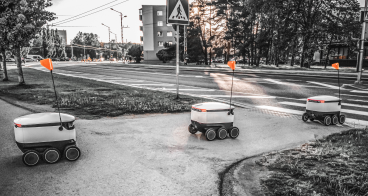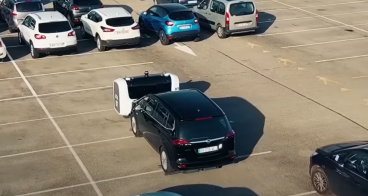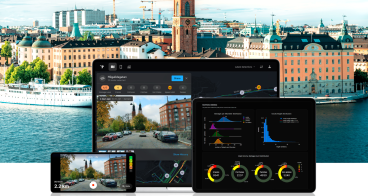Advancing Public-Area Mobile Robots: A Municipal Guidebook
The capability and reach of autonomous mobile robots are expanding rapidly, venturing beyond industrial settings like factories, farms and warehouses into the public domain - sidewalks, university campuses, airports, hospitals, and malls. This newer class of devices, called "public-area mobile robots" (PMRs), holds immense potential, while also presenting new challenges as the devices must navigate and interact among uninvolved human bystanders in the public right-of-way.
Automated devices and vehicles operating in public spaces will most often fall under the jurisdiction of municipal traffic departments, and may be deployed by public works departments to perform a variety of property maintenance tasks. They will be required to conform to accessibility guidelines and to follow pedestrian-like rules while giving way to humans in the right-of-way.
Balancing Opportunities and Challenges
PMRs are, as usual, a dual-edged technology. They address the growing demand for task efficiency amidst rising consumption, labour shortages, and demographic aging. However, introducing them into public spaces requires preparing cities and acclimatizing people for coexisting and interacting with automated devices.
Although they are most often seen performing local delivery for food and other goods, PMRs can be valuable for much more than delivery tasks, showcasing versatility in functions like EV charging, cleaning, inspection, monitoring, and more. Their potential applications are poised for significant expansion well before 2030.
Enablers of PMR Evolution
The protest of “robots will take our jobs", is being out-shouted by concerns of “we need robots to support the decline in available labour". The combination of de-globalization and falling fertility demands more agile mechanization to support consumption. In other words, in many populations the cry of “we need jobs to maintain our standard of living” is replaced by “we need robots in order to maintain our standard of living".
Here are six enablers for the growing PMR evolution:
- PMR existence has been made possible by recent advances in sensors, software, and mechatronics.
- PMR capability is made possible by technologies such as AI, GNSS, HD-mapping, lidar, and small electric motors and telecommunications.
- PMR competence has been boosted by two decades of innovation driven by four pre-cursor applications as developed for factories, farms, mines, and warehouses.
- PMR popularity has been recently accelerated by delivery, surveillance and sanitation robots in response to COVID.
- PMR adoption is facilitated by early legislation in several countries such as Estonia, Japan and South Korea as well as in more than 20 US states.
- PMR necessity is being underscored by labour shortages driven by aging populations in many countries and re-shoring in others.
The deployment safety of mobile robots that cross roadways is being made possible by SAE Connected Vehicle standards for road intersection systems developed for automated road vehicles. Traffic management systems for multiple fleets of PMRs on city walkways will be made possible by extending the multiagent orchestration systems developed for factory and warehouse applications. PMR safety impacts on pedestrian accessibility can be advanced by cities that complete upgrades according to applicable accessibility legislation and by enacting bylaws to guide (and enforce) safe operation within their jurisdictions.
The low barrier to PMR operation has been made possible by ubiquitous telecommunication systems and a generation of young video gamers willing to take employment as fallback teleoperators in low-speed, low-momentum operation for PMRs in various stages of technical maturity. In other words, PMRs do not suffer from the demand for fully autonomous, operational perfection that plagues the deployment of robotaxis.
How Can Cities Prepare?
PMR technology may have numerous uncertainties, and they will find many deployment constraints, but it is advancing rapidly and is almost certainly unstoppable. That does not mean PMRs will be admitted into every city or community. But it does mean that they will be admitted — and will need to be managed — in many cities and communities.
Hence, the adoption rate of PMRs is, and will remain, highly variable. Already, one city has about 300 PMRs in operation, well over 100 cities and communities have a few tens in operation, and a couple of cities have banned them. Most are still waiting and watching. And the number of cities observing attentively has grown dramatically since COVID.
Regardless of whether aggressively or cautiously, when introduced to any city or community it will be critical to maximize public acceptance by focussing on services perceived as beneficial, non-intrusive, and safe. This is pivotal to ensuring PMR acceptance. The technology may thrill early adopters, but only safety, transparency and public acceptance can entice the great majority of communities to admit PMRs.
How URF can help
At the Urban Robotics Foundation (URF), we are developing a series of municipal guidance documents starting with an Executive Guide and Discovery Guide to help senior municipal leaders, smart city teams and other stakeholders understand more about the challenges and opportunities of PMRs. The first two documents will be published in January 2024. URF's Project Guide to PMR Deployment will be published later in the year with the scheduling of workshops that are targeted to help Smart City teams, public works departments, and accessibility advocates collaborate and prepare for PMRs using the six foundations of governance we call "Pillars": Readiness, Behavior, Orchestration, Certification, Enforcement, and Monetization.
Bern Grush is the Executive Director of the Urban Robotics Foundation (URF), project leader for draft ISO 4448, and principal author of the forthcoming Municipal Guides to Public-area Mobile Robots. URF is a global non-profit organization funded by memberships, guidebook sales, and educational workshops. Membership is open to municipal, urban and traffic planners, accessibility advocates, public facility operators, technology companies, fleet operators, and researchers.






